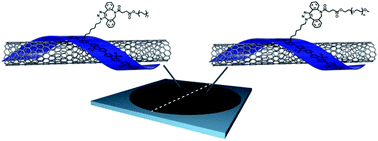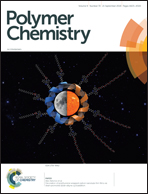Decoration of polyfluorene-wrapped carbon nanotube thin films via strain-promoted azide–alkyne cycloaddition†
Abstract
A generalizable method to decorate carbon nanotubes deposited as a thin film without damaging nanotube optoelectronic properties remains elusive. Here, reactive, noncovalently functionalized polymer–nanotube thin films were prepared using a polyfluorene that is decorated with azide groups in its side chains. The azides allow for Strain-Promoted Azide–Alkyne Cycloaddition to occur between the polymer–nanotube complex and strained cyclooctyne derivatives. It was found that quantitative functionalization of the nanotube thin film occurred efficiently at room temperature, without any catalyst or by-product removal required. This interfacial chemistry resulted in no damage to the nanotube structure or properties, as evidenced by absorption, fluorescence, and Raman spectroscopy. The polymer–nanotube thin films were investigated using thermogravimetric analysis, and it was found that the mass losses upon heating under an inert atmosphere were consistent with complete functionalization of the thin films. Using polyethylene glycol or C16 alkyl chains functionalized with a strained cyclooctyne, we modulated the hydrophobicity of the thin film and found that we could prepare Janus nanotube films via stepwise functionalization.



 Please wait while we load your content...
Please wait while we load your content...